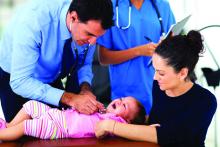Children born very preterm continue to display language difficulties compared with term controls at 13 years of age, with no evidence of developmental “catch up.”
Given the functional implications associated with language deficits, early language-based interventions should be considered for children born VP, investigators wrote in Pediatrics.
“Difficulties in language functioning in this cohort of children born VP remained stable from 2 to 13 years of age. Although generalized language deficits were observed, the VP group had marked difficulties on expressive components of language,” wrote Thi-Nhu-Ngoc Nguyen, BSc, of Monash University, Melbourne, and her associates.
Ms. Nguyen and associates assessed language skills using performance-based or parent-report measures in 244 children born VP (less than 30 weeks’ gestation) and 77 term controls, at 2, 5, 7, and 13 years of age. Compared with term controls, children born VP had poorer functioning across all components of language (mean group differences ranged from −0.5 SD to −1 SD; all P less than .05) at 13 years of age. At each follow-up age, the VP group displayed poorer language functioning than did the term controls, with the groups exhibiting similar developmental trajectories (slope difference = −0.01 SD per year; P = .55). “With our findings, we emphasize the need for effective and timely interventions for language skills in children born VP to close the gap with their term peers,” the investigators concluded.
Read the full story here.
acruz@mdedge.com
Children born very preterm continue to display language difficulties compared with term controls at 13 years of age, with no evidence of developmental “catch up.”
Given the functional implications associated with language deficits, early language-based interventions should be considered for children born VP, investigators wrote in Pediatrics.
“Difficulties in language functioning in this cohort of children born VP remained stable from 2 to 13 years of age. Although generalized language deficits were observed, the VP group had marked difficulties on expressive components of language,” wrote Thi-Nhu-Ngoc Nguyen, BSc, of Monash University, Melbourne, and her associates.
Ms. Nguyen and associates assessed language skills using performance-based or parent-report measures in 244 children born VP (less than 30 weeks’ gestation) and 77 term controls, at 2, 5, 7, and 13 years of age. Compared with term controls, children born VP had poorer functioning across all components of language (mean group differences ranged from −0.5 SD to −1 SD; all P less than .05) at 13 years of age. At each follow-up age, the VP group displayed poorer language functioning than did the term controls, with the groups exhibiting similar developmental trajectories (slope difference = −0.01 SD per year; P = .55). “With our findings, we emphasize the need for effective and timely interventions for language skills in children born VP to close the gap with their term peers,” the investigators concluded.
Read the full story here.
acruz@mdedge.com
Children born very preterm continue to display language difficulties compared with term controls at 13 years of age, with no evidence of developmental “catch up.”
Given the functional implications associated with language deficits, early language-based interventions should be considered for children born VP, investigators wrote in Pediatrics.
“Difficulties in language functioning in this cohort of children born VP remained stable from 2 to 13 years of age. Although generalized language deficits were observed, the VP group had marked difficulties on expressive components of language,” wrote Thi-Nhu-Ngoc Nguyen, BSc, of Monash University, Melbourne, and her associates.
Ms. Nguyen and associates assessed language skills using performance-based or parent-report measures in 244 children born VP (less than 30 weeks’ gestation) and 77 term controls, at 2, 5, 7, and 13 years of age. Compared with term controls, children born VP had poorer functioning across all components of language (mean group differences ranged from −0.5 SD to −1 SD; all P less than .05) at 13 years of age. At each follow-up age, the VP group displayed poorer language functioning than did the term controls, with the groups exhibiting similar developmental trajectories (slope difference = −0.01 SD per year; P = .55). “With our findings, we emphasize the need for effective and timely interventions for language skills in children born VP to close the gap with their term peers,” the investigators concluded.
Read the full story here.
acruz@mdedge.com
Content Gating
No Gating (article Unlocked/Free)
Consolidated Pubs: Do Not Show Source Publication Logo

